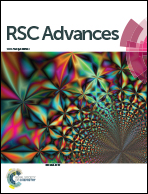Rutin detection using highly electrochemical sensing amplified by an Au–Ag nanoring decorated N-doped graphene nanosheet†
Abstract
A hybrid nanostructure of Au–Ag nanorings prepared by decorating the surface of N-doped graphene (NG) was utilized as an electrocatalyst to construct a novel electrochemical sensor. Transmission electron microscopy (TEM) and X-ray photoelectron spectroscopy (XPS) were used to characterize the as-prepared composites. The Au–Ag nanorings/NG modified electrode exhibited a much better electrochemical response of rutin than that of Au/NG, Ag/NG and NG due to the synergetic catalytic effect between the Au–Ag nanorings and NG. Under optimal conditions, the electrochemical sensor of the Au–Ag nanorings/NG exhibited a wide linear range from 0.05 μM to 241.2 μM (S/N = 3) with a low detection limit of 0.01 μM. In addition, the proposed sensor also displayed good anti-interference ability and long-term stability, which had promising applications in bioassay analysis.


 Please wait while we load your content...
Please wait while we load your content...